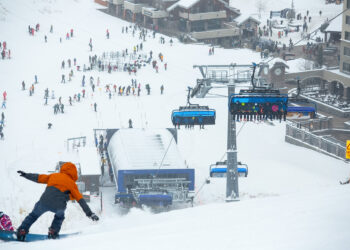Study outlines finances, benefits and drawbacks of different governance options for Big Sky
By Jen Clancey STAFF WRITER
On Monday, Nov. 17, the Big Sky Governance Study team held its final meeting with residents, presenting results of a year-long dive into governance options for Big Sky.
Outside of Big Sky’s option to maintain the status quo as an unincorporated community occupying both Gallatin and Madison counties, the research team presented three other options: basic incorporation, expanded incorporation and creation of a new county. The study, funded for $329,750 by the Big Sky Resort Area District, is meant to be a non-biased resource to inform local decision-making, if residents desire a change to the current structure of representation in the community. Across the three options presented, Big Sky’s resort tax will be preserved.
“This is simply a fact finding mission, because unfortunately, there have been a lot of rumors— there’s a lot of misunderstanding, mistruths, and I don’t think they’re intentional. I think they were just a lot of different people’s opinions and facts that mixed around,” said Sarah Blechta, chair of both BSRAD and BSRAD’s Incorporation Exploration Subcommittee for the study. “And so really finding a way to have very clear facts was another reason that Resort Tax was involved.”
First, WGM Group—the consulting group leading the study—presented details behind the basic incorporation scenario. Sarah Emmans, fiscal analyst from SME Consulting, and Lee Ann Ryan, senior project manager for ECOnorthwest shared the finances behind each of the options. If Big Sky wanted a small, efficient municipal government, this option would result in a system with a mayor, public works, city council, planning and code enforcement and finance and administration capabilities.
To fund this type of government, property owners in Meadow Village, Town Center and Mountain Village—areas with the minimum population density needed to meet Montana code—would owe 42 mills, or about $958 per year in taxes for an average owner-occupied home, according to Dylan Pipinich, WGM land planner and study leader. This municipal tax would be added to existing county and district levies. Second homeowners would pay more, after two new state laws created a tiered structure of taxes for second homes in the state.
The expanded incorporation model would see more than double the amount of taxes required—$1,948 for the average home in the boundary—to form a more robust municipal government and efficient service delivery. Again, mills for this new government would be added to existing county and district levies. Elements that could be included in the expanded model are a community development office, human resources staff, a judge and city attorney, a city council, a mayor and finance teams.

Lastly, a county creation model would result in $1,513 in taxes for the average home within both the county and incorporated boundary—this model would include incorporation of a town within the more densely populated areas. In this case, residents would no longer be paying Gallatin and Madison County as they fund the new county in which they reside. Those in the county but outside the incorporation boundary will pay less, in the form of a county tax at 29 mills, compared to the 67 mills total for property owners within the municipality.
“It offers the highest degree of local control but also the most challenging implementation path, requiring legislative action, voter approval, and substantial administrative startup,” the report stated about creating a new county.
Other alternatives include a charter county government, which allows for a new form of cooperation between Gallatin County and Madison County. Other options could be strengthening special districts by expanding and adjusting the authority of special districts, or enhancing representation through advisory boards and staff positions in county government.
With report complete: what’s next?
With the study over, the question on many Big Sky residents’ minds surrounds future steps. Not the study team, nor any other organization, is responsible for moving recommendations forward.
The study will be a resource for the community if residents decide they want change. When BSRAD funded the study, Blechta explained, they made sure it would avoid recommending any potential options, and instead serve as a robust guide of facts outlining options for Big Sky residents.
“We have paid for the study with the intent that we can arm our community members with the data and the facts so that they can choose what their next steps are,” Blechta said. “So I would turn it back to everybody here. You get a choice on what you make your next step and then we’ll all go from there.”
Pipinich was impressed by the turnout at the Monday event. Before 5:30 p.m., seating in the room was already full, requiring more chairs to be brought in for residents still filtering in. He noted that the engagement from the community was already a good sign for future collaboration.
“My opinion is, whatever you choose your next steps to be, just the fact that you filled this room and asked the questions that you asked, your next steps will be in the right direction,” Pipinich said.
Meg O’Leary, president of M20 Group and head of community engagement on the study, thanked attendees, some new and some who have attended each session, for following with the study and providing feedback along the way.














